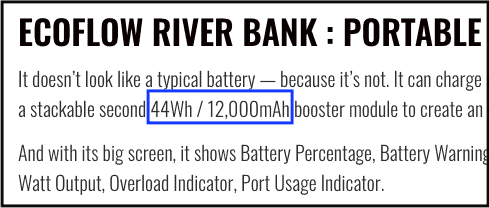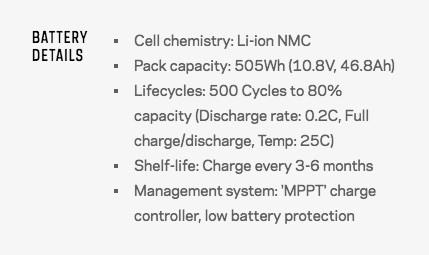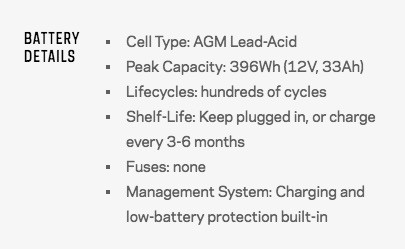The battery capacity of any device is critical. However, this importance is based on certain facts. First of all, what exactly does battery capacity mean?
Understanding Battery Capacity
Battery capacity, in simple terms, is the amount of energy that can be extracted from the battery.
That being said, in the product specifications of solar generators, you’ll see each one has the specification simply listed as ‘Battery Capacity’.
This figure is displayed to you in either watt-hours (Wh), ampere-hours (Ah), or milliampere-hours (mAh).
For instance, when searching for specific power banks, after you see ‘Battery Capacity’ listed in the specifications section, you might see figures like ‘20000mAh’ or ‘400Wh’.

Similar: Portable Power Banks – What To Look For Before Purchasing
The higher the number, the bigger the battery.
But make sure to understand the difference between mAh and Wh before deciding what to buy.
This is because the value that precedes mAh may look to be more powerful than Wh if solely basing off of the numbers themselves, however, the opposite is usually true.
How to Convert Milliampere-hours (mAh) to Watt-hours (Wh)
The nominal voltage of a lithium-ion cell is between 3.6-3.85V depending on some internal factors within the battery.
There could be multiple cells in a solar generator, but in portable power banks they usually only consist of one lithium cell.
Example 1. Lithium Power Bank
For the previous example in the screenshot above, the EcoFlow River Bank is listed at 12,000mAh.
Since this is a portable power bank and is relatively small, we can assume that it only has one lithium cell.
To convert to watt-hours, we divide the 12,000 by 1,000 to get ampere-hours (Ah) and we get 12Ah. Next, we multiply by 3.7V and get 44.4Wh.
Whether you multiply the ampere-hours by 3.6, 3.7, or higher, you will get a good estimate of the watt-hours within your lithium battery.
Example 2. Lithium Solar Generator Batteries
Now, let’s look at the Goal Zero Yeti 400 Lithium and 500X. Pictured below you can see the Yeti 400 Lithium battery details:

The Peak Capacity is listed at 428Wh (10.8V, 39.6Ah). Now, you can see that mAh were already broken down into Ah (39.6Ah = 39,600mAh).
If we multiply the 39.6 by 3.6, we get only 142.56Wh. Why? This is because there are three lithium cells in the battery.
You can tell this because it lists the peak capacity at 10.8V. Since the nominal voltage of a single lithium cell is 3.6-3.85V, we can multiply this (3.6V) by three to get 10.8V.
So, we will start at square one to get the correct watt-hours. 39.6Ah x 3 (lithium cells) x 3.6 = 427.68Wh.
And there you have it! We have just converted the mAh (or Ah, in this case) to Wh. You can use this math with any of the future batteries you intend to use.

Using what we just learned, we can apply this to the Yeti 500X’s battery.
Peak Capacity is listed at 505Wh (10.8V, 46.8Ah). Let’s take the 46.8Ah and multiply it by three and then by 3.6 to get 505.44Wh (46.8 x 3 x 3.6).
Example 3. Lead-Acid Solar Generator Battery
Since the Yeti 400 uses a lead-acid battery, it has a different nominal voltage because it is a completely different type of battery.
The nominal voltage of a lead-acid battery is two volts per cell. The Yeti 400 has six cells because it lists the voltage at 12V as seen below:

The Peak Capacity is listed as 396Wh (12V, 33Ah). The amp-hours are already broken down from mAh (33Ah = 33,000mAh), so we can multiply 33Ah by two and then by six to get 396Wh (33 x 2 x 6 = 396).
We got to the number six by dividing the 12V (listed in the Peak Capacity – See image above) by 2V, which is the nominal voltage of a lead-acid battery.
Check out this in-depth post from batteryuniversity.com for more detailed information on battery voltages
Solar Generator Maintenance for Battery Longevity
In order to maintain your solar generator for years down the road, you want to follow some basic steps that can help extend the life of your generator.
Simple maintenance and understanding of the battery could save you from having to buy a new generator too soon.
Here are some basic tips for you and your new solar generator:
1. Avoid deep-cycling the battery
Deep cycling basically means draining the battery completely before recharging.
Lithium-ion batteries do not need deep-cycling and it harms the battery.
This strategy was only effective for Nickel-Cadmium (NiCd) batteries. The materials inside the older batteries are engineered completely differently than current lithium-ion ones.
2. Recharge the battery before storing it away
This is a MUST because the battery will not function at its best if you leave it on low battery for months before use.
Recharge it and store it away for whatever occasion you may need it for.
3. Do not exceed the maximum solar input
Every solar generator has a listed maximum solar input. This can be either in watts (W), amps (A) and volts (V), or both.
By multiplying amps and volts together, you get watts.
If you’re using a DIY solar generator, you may need to review your charge controller limits to make sure it can handle the solar input from your array.
Do not exceed this or the battery may burn out. This is an easy one to screw up if you do not know the wattage of the solar panel(s) you’re using.
